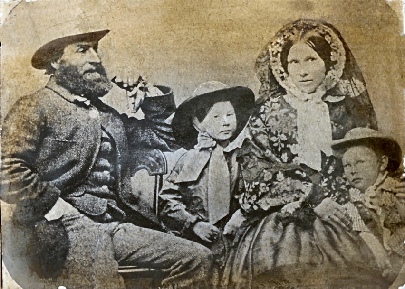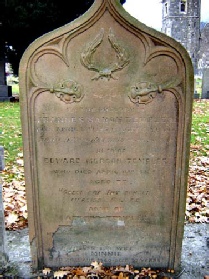Edward Merson Templer
Edward Merson Templer together with his brother John Arthur were one of the first pioneers to both Australia and then New Zealand
IN MEMORIAM - Edward Merson Templer
(Died 4th April 1897.)
(Written for publication by Michael Scott Campbell a former partner of E.M.T.)
The ranks of old Canterbury squatters under the relentless hand of Time. Up to within the last two or three years he was a hale and. active man, and. at 75 looked least five years below his age. Two years ago however, he was struck down with very serious illness, during which he suffered much. This combined with the terribly cold season, which we then experienced, proved too much for him, and he was never the same man since. His old haunts began to know him no more: his friends to miss the sight of his once familiar figure: and even the Public Library, at which he used to be a constant visitor began to be beyond his reach. Still his intellect continued to be as bright as ever: and those of his friends who knew him really well know that that means. Always pleased to see anyone who called., and ready to talk on any subject, let it be the news of the day, history or what not, on very few subjects would you find him astray. So well stored with information was his memory, the fruit of many years of constant and discursive reading. A very old Australian settler was Mr. Templer: could give much and varied information as to that country in the early days. To hear him and an old crony go-over bygone times was a treat I have often enjoyed. I once, some four years ago, had an old South Australian to meet him at my house. I sat by and listened, putting in a word just now and then, to elicit some information perhaps. They had both travelled the Australian Continent widely and knew it well - places - men and things. They went back as far as 184O, (Templer arrived in Australia in 1843.) discussing many men, some of whom I knew, at any rate by name or hearsay, and many matters of old interest too. When they had finished the Adelaide man went into the next room, Mr. Templer stood up and stretched himself, “Ah,” he said, “I have seen a procession of ghosts go by today. And my other friend told me later, there are not three men in Australia with whom I could have had the yarn I have had this afternoon with Mr. Templer.”
And now some slight sketch of his career. The last few years before coming to Australia, he spent upon the Continent, travelling from place to place, most of his time being spent in Florence and Dresden. He was pretty well a perfect master of Italian, French and German, and could sing “A Ravir” the song in any of the three. As to his singing, he had, I think, the finest and most cultivated voice that I have ever heard out of the profession. I talk of foreign languages, his English and Irish were equally good, his Molly Carew inimitable: Scotch songs, I do not think he much affected, and the comic was not his line unless of the keenest humour.
In 1839 at the age of 20, he left England with his brother John Arthur, two years his senior, and landed in Sydney either late the same year or early in 1840. (This is queried by the 1972 copiest because he saw a diary of James Lethbridge Templer (d.1845) the poet who in a diary of that year describes Edward Merson arriving at Sydney. The diary was in the possession of a Mrs. Prior in Chichester England when he visited her in 1943.) They almost immediately started on pastoral pursuits and established their first station somewhere in the Clarence country, New South Wales.
In 1851 he came to Canterbury, N.Z. with 2,000 sheep in a German ship (the Zealandia). Details of the journey are in Captain Mark Stoddart’s Journal in the Canterbury Museum. Like many such situations in these days a ship as crowded as this one was with added problem of language could have been serious had not Templer been competent in the German. He married Jane King in Lyttleton in 1852. Their first station was at Sands Knolls about 20 miles west of Christchurch. In 1855 and 1857 he returned to Bathurst New South Wales where he seems to have retained interests after he settled in N.Z. His brother John with whom he had been in partnership had remained near Bathurst at a run called Narrambla until 1875 when he too settled in Canterbury. In 1858 he took over the lease of Coringa which was to be his home until he sold it in 1882 and where most of his children were born. The homestead which he built there in 1865, a wooden building still stands alongside the entrance to Christchurch’s international airport. The airport is built on what was part of the run, (run is a large farm usually used for the grazing of sheep). In 1863 he entered into partnership with his brother—in—law M.J. Campbell, the author of this memoriam in the purchasing of a very famous station called Longbeach near Ashburton in South Canterbury. A few months later saw the arrival of Messrs Russell and Grigg upon the scene. These gentlemen furnished with a large capital, immediately commenced the purchase of land upon the run (which was leasehold) lined the running creeks with sections, picked out the eyes of the country and eventually as a run it was “spotted” off the map. Templer and Campbell of course, also purchased land in self-defence, up to the limit of their more slender capital. In the end by sale to Grigg of their purchased land, hundreds of acres to the others thousands, together with what was left of the run; aided too by the breaking out of the West Coast gold-diggings, and the consequent advance in the value of cattle, they came fairly well out of the transaction. The sale to Messrs Russell and Grigg was effected towards the end handed the of 1865 and they handed the station over to Mr. John Grigg in 1865. It is one of the show places of our country where the Queen stays when on a visit here and, still owned, or should I say, a small farm out of the original station by a member of the Grigg family. It was and is one of the few places in Canterbury with an abundance of running streams.
While resident at Coringa, Mr Templer sat for some years as member for Avon in the old Provincial Council, (N.Z. was governed by seven Provincial Councils until 1876 when they were abolished in favour of a central parliament.) Templer was no believer in central government. (Probably because Canterbury was the only province, with a financial surplus. Their old Parliament house still stands and for years was the meeting-place for the synod of the diocese.) In Provincial politics he was a staunch supporter of Sefton Moorhouse and the two men were firm friends. After the abolition he took no active part in politics but always watched them from a distance: was a close reader of Hansard; and always a keen critic of legislative action. He would, I think, have described himself as a Radical; but was I fancy hardly so much so in feeling as in speech.
In disposition he was warm hearted, affectionate and generous, to a degree. I have known him put down a good subscription in many a case of need and often take upon himself responsibilities on account of old friends which not infrequently fell back upon himself.
In temper he was hot and hasty; quick to anger but ready enough to forgive. And if hot he was chivalrous withal. If he made an enemy occasionally he seldom kept him for long. He had many friends in the old days. In these later not so many. The old had mostly died out or moved away; and of late he moved about so little that he did not easily make new ones. Still, more than a few will remember him and regret him, once know the inner man of him and one can hardly fail to like and even love him.
To the writer he was the oldest and best friend in Canterbury —— he will miss him much and can hardly hope to find such another on this side of the Great River.
To his family he will be an irreparable loss and they will never fail to feel it so; but when they consider his weak health of late years and much suffering, will hardly regret that he has passed away. A good man is gone.
Requiescat in pace!
8th April.1897.
A note by Canon John M. Templer copyist and grandson of E. M .Templer
E.M.T vas buried in the churchyard of St Peter’s Church, Riccarton. He was probably the first to be buried here and may have given the land for the Church. His grave is just inside the gate on the West Coast Road. With him in the same grave are his two eldest children, a daughter who died in infancy and Arthur who was childless. The headstones have recently been removed and placed on the fence-line close to the grave. I cared for it during my stay as Vicar of Hororata some 40 miles inland, in 1945-52.
About 1960 Prebblton School held their Centennial celebrations. E.M.T. had presented the land for the school. It no doubt had been part of his run, Coringa. At the time of the celebration they wrote and invited me. Unable to go I passed on the invitation to my son John who was then at Canterbury University. He attended and in replying to the toast to ”the Pioneers” he was able quote a small reference to his great-grandfather mentioned by his great friend Mark Stoddart who accompanied him on his first journey to this country. Stoddart with an Aiken (both of Horarata) and another who is unnamed were the first to visit a large inland lake (L. Coleridge) 25 miles from Hororata.
They spent the whole day going through unexplored country on horseback and stopped at the lakeside to brew some tea. The other three were happy to call it a day bit not so E.M.T. he must be on over the next hill to see what was on the other-side.
This John by the way is living up to the tradition teaching as headmaster of a British Senior Primary School on the island of Tanna in the New Hebrides.
Stoddart’s Journal from which I quote, is in the Canterbury museum in Moorhouse Street in Christchurch. The name Templer is commemorated in Templer Street in Avonside, Templer’s Island in the Waimakariri, and originally included in Coringa. Templeton is also named after E.H.T.
In 1944, I visited Collumpton, Devon, where E.M.T’s father was Vicar and is buried in the parish church beside the alter. The then Vicar moved the carpet to show me his grave.
While serving a curacy in New Plymouth in 1956 I came across a daughter of Archdeacon Govett, an early Vicar of N.P. She remembered E.M.T visiting her father from Christchurch and testified to his singing ability. They had been to school in England together.

